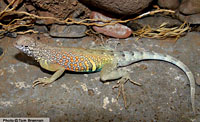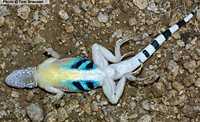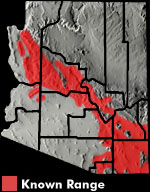Online Field Guide to The Reptiles and Amphibians of Arizona


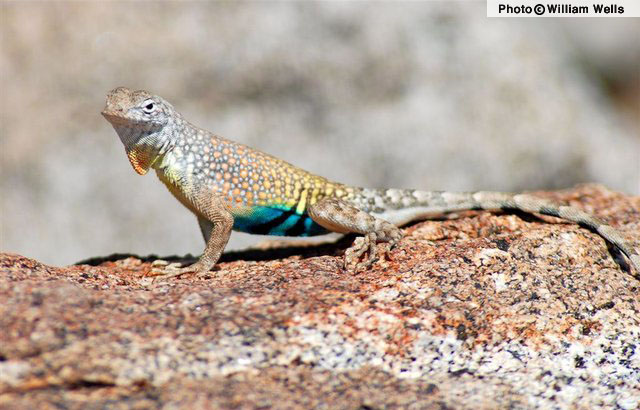
Arizona
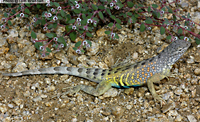 Maricopa Co., AZ |
| GREATER EARLESS LIZARD Cophosaurus texanus | |
|
DESCRIPTION: A medium-sized (up to 89 mm or 3.5″ from snout to vent), gray or tan lizard with long, slender limbs and a flattened tail. The underside of the tail is marked with distinct black crossbands on a bright white background. The upper surfaces of the body are marked with tan, yellow, or peach spots surrounded by off-white or cream speckles. The groin, lower back, and forelimbs are often tinted yellow on males. The back of the thigh is marked with a dark horizontal line. There are two dark bars on each side of the belly that extend up onto the sides just in front of the hind limbs. On males these bars are surrounded by light blue patches on the belly. On females bars are faint or lacking. During breeding season females develop a pink throat patch and a peach or orange tint on the sides and flanks. The body scales are small and granular. As its common name implies, this lizard lacks external ear openings. This characteristic, coupled with the posterior position of its side bars distinguish the Greater Earless Lizard from the similar looking Zebra-tailed Lizard. DISTRIBUTION: This lizard is found across sub-Mogollon Rim central Arizona and throughout much of the southeastern portion of the state at elevations ranging from about 900’ to 5,000′. HABITAT: The Greater Earless Lizard inhabits Arizona Upland Sonoran Desertscrub, Semidesert Grassland, Interior Chaparral, and Great Basin Conifer Woodland communities. It is usually encountered above the flats on relatively open, gravelly slopes and along sandy drainages within mountainous terrain. BEHAVIOR: This diurnal lizard is often encountered basking in the mid-morning sun. It hibernates during the cold months of winter and late fall. When approached by a predator it often curls and wags its tail over the back exposing the black and white stripes. This may be to let the predator know that it has been spotted by the lizard. If the predator knows it has been spotted it might not invest the energy required to chase this speedy lizard. When fleeing this lizard often runs with its tail curled over the back. This may serve to divert the predator’s attention to the tail (which can be regenerated). Both males and females are territorial and exhibit head bobbing, push-ups, and lateral compression of the body when approached by an outsider. DIET: The Greater Earless Lizard feeds on a variety of insects including grasshoppers, butterflies, moths, bees, wasps, caterpillars, beetles, and ants. It also eats a variety of spiders. REPRODUCTION: This lizard mates in spring and lays one or more clutches of eggs in spring and summer. Clutch size ranges from 2 to 9 eggs. Hatchlings begin to emerge in July. By Thomas C. Brennan Brennan, T. C., & A. T. Holycross. 2006. A Field Guide to Amphibians and Reptiles in Arizona. Arizona Game and Fish Department. Phoenix, AZ Brennan, T. C., & A. T. Holycross. 2005. A Field Guide to Amphibians and Reptiles of Maricopa County. Arizona Game and Fish Department. Phoenix, AZ Stebbins, R.C. 2003. A Field Guide to Western Reptiles and Amphibians, Third Edition. Houghton Mifflin Company, Boston, MA |
|
Visit Partners in Amphibian and Reptile Conservation:


HOME
Copyright © 2023, Arizona Game and Fish Department. All rights reserved.
If you make use of the textual contents of this site in reports, publications, etc. please cite and credit the author(s) and photographer(s). All photos on this website are copyrighted. However, those found in the species account section may be used for any noncommercial scientific, educational, or conservation purposes provided that photographs are not altered and continue to bear the copyright symbol and name of the photographer. Please contact the photographer regarding commercial use of copyrighted photographs.










